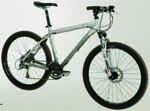 FRAME
FRAME
Giant uses an Offset Neutral Plane to increase the theoretical size of the frame and improve lateral rigidity. Circular tubing’s neutral plane is along the central axis, whereas a triangle is nearer the flat edge. So, by using triangular tubes, with pointy edges inward facing, you get a stiffer frame with no increase in standover height.
To create the shape of the tubes Giant uses fluid forming. As well as the organic forms possible, this also increases the tensile strength of the material as the grain structure is compressed. The rear of the frame also gets plenty of attention, a less pronounced version of the triangular tubing is used for both the seat and chainstay. Tall triangular chainstays go some way to explaining the super stiff ride.
A lack of any hose guide in the centre of the top tube (thanks to the super thin tubing’s inability to cope) means the hose can ping around a bit, but swapping the clip-on guides for zip-ties soon remedied this.
FORKS
With only 80mm of travel, the Recon 351 forks are the shortest travel on test and emphasise the race-ready layout. Motion Control damping offers a slightly more refined ride than the Turnkey adjustment on the Orange’s Toras, and it has a far wider range of usable adjustment. The 32mm stanchions and the hollow crown, combined with excellent bushing overlap, made these the stiffest forks on test; and because the wheel goes where you point it, experienced riders managed to pilot the Giant through some pretty serious situations.
WHEELS
Despite having the smallest tyres of any bike on test, the wheel package outweighed everything else. As almost every bike on test shares the same Shimano hubset, the additional bulk comes from the Mavic 117 rims and the Kenda tyres. Despite the minimal width and fast rolling, rubber compound, the Kharisma 2s are not the low-weight, race-ready rubber they make out to be. In their favour the stepped sub-tread and widely-spaced main blocks offer plenty of directional traction and do a fair job of sticking to the trail when braking.
COMPONENTS
While the Race Face cranks may not be as stiff as the hollow Shimanos or two-piece Truvativs, they are a splined interface model and chainring life is excellent, something which cannot be said of any Shimano chainset (bar the new XTR). LX Double Tap shifters offer a choice in techniques for reducing cog sizes: either thumb only or thumb and finger. Seasoned riders may not notice the addition, but newbie’s at least get the choice. Own-branded finishing kit is reliable stuff and the bar shape is spot on. Just make sure you are happy with the stem length; we’d swap for a 20-30mm shorter model in the shop if we could.
PERFORMANCE
Giant’s triangular tube fettling makes for a laterally rigid chassis. Unfortunately vertical stiffness isn’t in the same league. While this may suit the race crowd that the bike is aimed at, long rides beat the rider — badly. Last year’s bike had bigger tyres to partly combat this but now the small-volume rubber fitted merely adds to the harshness. Geometry wise, Giant has not gone full-on race. Head and seat angles are totally ‘trail rider’ friendly, and the balance of the bike is very good. It’s easy to just get on it, and ride.
VERDICT
For shorter rides and fast blasts, the Giant was one of the first choices. As we have come to expect, spec on the XtC 2.5 is up there with the best, the quality of the fork being one notable highlight. Small, fast rolling tyres help with the sensation of a fast bike, and the lack of flex directs all your power into forward motion. That’s fine on smooth trails, but when it gets tech, the lack of any compliance in the rear end hampers speed. The bike bounces around, and shocks are passed directly to the rider.
Undoubtedly the Giant is fast, but there are certainly better bikes for a big day out in the hills. Choose your weapon wisely.
MBR RATING: 8/10



